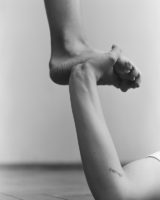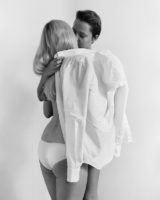Margo Ovcharenko was another photographer on my list of possible interviews. I had been following her work of the past few years, and time seemed ripe to learn more about her background and work. The following conversation was conducted via email.
Jörg Colberg: Can you speak a little bit about your background? How did you become interested in photography?
Margo Ovcharenko: I got my first camera when I was 15 years, while in high school. Back then it was definitely a tool to discover my own sexuality, my body and a way to interact with other people. I used to be a shy teenager and owning a camera gave me a lot more confidence to approach my peers. I still feel very special when people pose for me, especially naked. I think that I use my camera just the same way, only it’s a lot more focused now. I’m still amazed by the society and the people, but I’m more fascinated by personal experiences that exist in historical context.
Also, I have a law degree and I’m a pretty awful lawyer, not because I can’t pay attention to details but because I’m too idealistic. I don’t think there would be any other way for me to be a female artist coming from a modest background in Russia if I wasn’t in denial.
JC: Your work centers on portraiture, so I would be curious to learn a little bit about your general ideas of the genre. Are there artists you draw inspiration from?
MO: First, I believe that a portrait with one person in the frame is never just that one person. It’s always the viewer and the artist as well those who are portrayed, whether you look at a painting by Titian or a contemporary photograph. I appreciate artists who work with this issue and avoid exploitation, who acknowledge that their subjects participate as much as them. There are a lot of ways to do so and not all of them should be regarded as conceptual photography. For this and other reasons, I gravitate toward works of Collier Schorr, Leigh Ledare, Roni Horn, Joanna Piotrowska and Torbjørn Rødland. I also appreciate how Doug Dubois dealt with it in My Last Day at Seventeen. Sometimes being sincere in accepting the idea that the people you photograph have totally different experiences and doing your best to listen to them is half of the job.
Some of the artists named above are interested in visual legacy and the idea of figurative art more than interpersonal relationships, which is not entirely the case for me. My portraiture is content based and political, but I don’t want to limit myself to always work this way.
For my current project, I look at a lot of constructivism in photography, as well as architecture and design. I sort of have a love-hate relationship with these artists, that era in general. You can’t get away from the political component of it however extremely formally appealing those images are. But at some point I decided that I just want to own it as a part of my history, to have this visual legacy as a part of my visual language.



JC: What would exploitation in portraiture be?
MO: Assuming in the way you photograph your subject’s experiences, feelings or desire to be represented a certain way.
JC: And can we talk about the role of politics for you? You say your portraiture is political, but you seem to have a problem with the politics in constructivism (if I’m understanding this correctly). What role does politics for you play in your photography (if any)?
MO: I believe that art can take a political stance and often I’m interested in such art. But I think that at some point constructivism harboured political crimes, such as Stalin’s Gulags (forced labor camps). Photographing prisoners as “happy and reformed” — To me it’s the line that should never be crossed.
JC: When teaching, I often encounter the challenge of a student not being sure how to approach a subject, how to guide them (if at all). Could you talk a little bit about how you work with models/subjects?
MO: When I was 19 I attended a workshop by Hellen van Meene. I learned two important things from her. First, that it’s very important to make your subject feel comfortable and confident, especially if you need to do something out of the ordinary. Second, it’s okay to crop out limbs. But actually, I think that having this kind of a relationship between me and my subject where both of us contribute is extremely important to me. I talk about my concept and what my inspirations are to the people I photograph so they can participate. Also, I’m trying to find out if there are experiences we share. Even if they are very painful ones, like being objectified and patronized, or being confused and depressed. In my opinion, the most important thing one can do is to encourage your subject to help you make a great photograph.



JC: I think the first project of yours I saw was Hermitage, which focuses on romance and sexuality. Can you speak about the work and its background?
MO: It is about romance and sexuality, but I also tried making it into a “hard to fit into adult life” kind of story. In some of the images my subjects reenact their childhood memories of being punished by their parents or their teachers. A lot of these things are hardly considered in Russia as child abuse, one might say that it is just rough upbringing. That’s not something that is at the forefront of this work, but it also isn’t part of an adult life. But we all know how this affects people’s capacity to empathize or to engage with another human being.
Some of the images have focus on the surface of the skin, like rashes or bruises. Which to me, of course, is a way to show the materiality of the body, but also a metaphor for a kind of friction with the real world that it has.
Another thing that is worth mentioning is that it was all shot in a period of 2-3 months, when I moved to Saint Petersburg and rented my own room. I would invite people to come over, to chat and to make pictures. And with the topics I was interested in at the time, a lot of it felt like confessions. I lived close to the Hermitage Museum where I went when I could, and I like the idea of a hermitage, like a sanctuary in the city.
JC: Furious like a child and now Country of Women appear to shift gear a little, centering on girls and young women. How did these projects start, and what is your general thinking about them?
MO: Furious like a child is a project with a complex narrative structure which includes images with children during their rehearsals in rhythmic gymnastics, portraits in my improvised home studio, personal archive and images of tombstones. The portraits in my home studio are an exploration of stereotypes in posing and objectification. The girls, either dressed up by me or sometimes naked, pose in a way that clashes sex appeal and the idea of innocence. To photograph this collision was a game to me, and to try to take both sides, be it object/subject, women/camera, photographer/subject. In some of the images, girls pose in sports inspired poses, which ties it up to the images of younger gymnasts. A few months before I started this project, a female friend of mine, who is Canadian, and I discussed how our parents loved the Olympics. And then I thought that it’s such a strange concept that a tiny female body is supposed to represent the power of the state. That it is supposed to endure. That my body at some point represented it in competitions, even regional ones. Then I read Fascinating Fascism by Susan Sontag where she speaks of an athlete’s body that is cold and asexual, that does not experience pain and so on. So I strived to reverse it in my images.
Making images of gymnasts was the most challenging thing I have ever done, because I tried recreating what I was afraid of when I was a child – that some strangers will come and see me swinging my legs open in public, that my leotard is too tight, that I will fail, that I’m too thick and so on.



This entire project is a way to show fear and discomfort that lies deep within the lives of young women living in post-soviet Russia. I want to come back to working on it this summer, shooting in my hometown because I feel that I need more material.
The Country of Women project is also very personal and also has connection to sports to some extent. It’s a series of black and white photographs of queer women in the former USSR countries. As a pansexual women, I want to do something with the overwhelming sensation of disillusionment experienced by me and many of my generation who believed in the possibility that their nations would embrace queerness as such and that the hostility towards it will gradually come to an end. I feel a need to give lesbian, bisexual and pansexual women a voice and a body and a way to connect with the absent queer visual legacy in the post USSR era. I am imagining what it would be like if Varvara Stepanova and Rodchenko did a series of photographs of lesbian communes and my project came after this, to which I can feel connected through the theme and the place. Like in Furious like a child, I use physical tension as a metaphor of a physiological tension. This time I use a somewhat reversed approach: an inherently sexualized subject of queerness is shown through supposedly asexual posing and overall aesthetics reminiscent of Soviet-era propaganda. This way the visual identity of female queerness leans toward powerfulness, yet remains in the realm of attractiveness, with the latter being a device for female empowerment in my work. I’m still working on it, and so far I photographed in Russia, Ukraine and Belarus women I never met before, who responded to my ads in LGBTQ media. I also photograph whoever comes forward, not choosing people based on their age or appearance.
